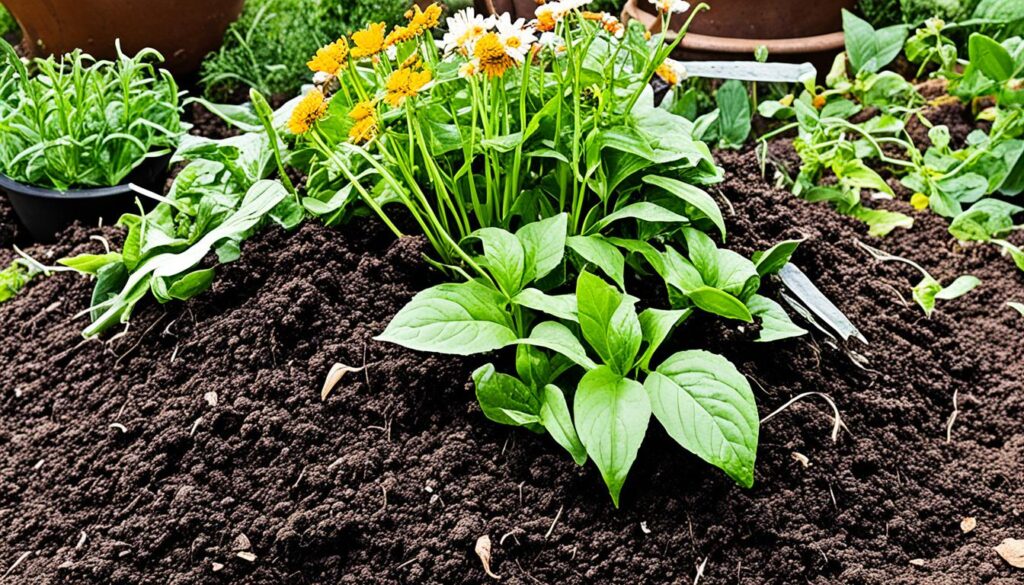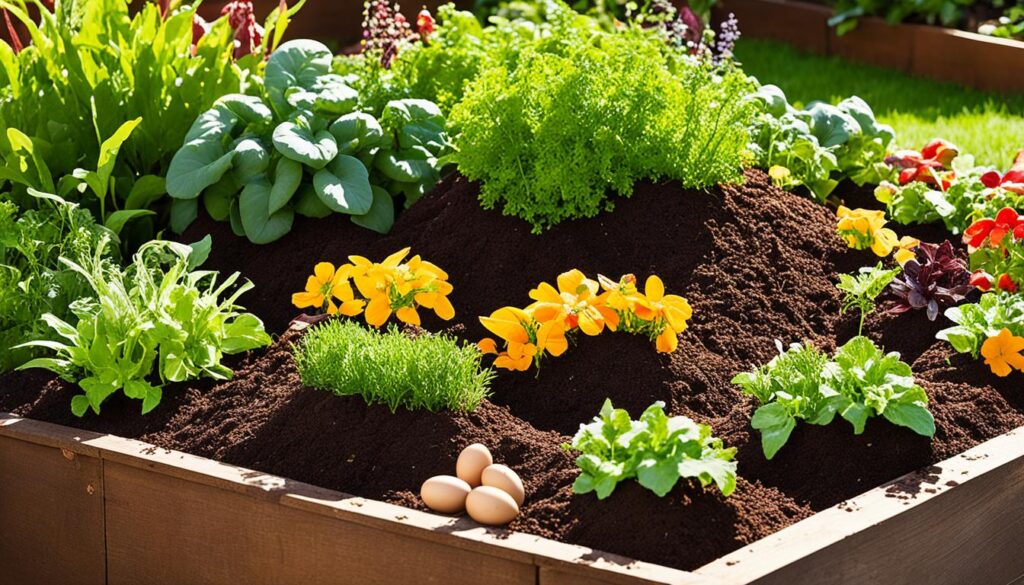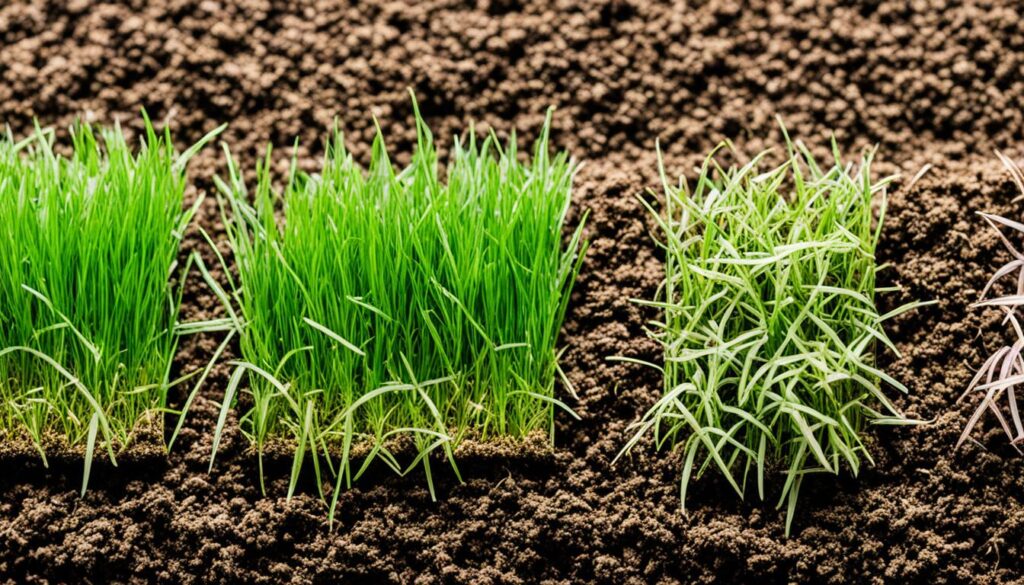Did you know a single banana peel has about 422 milligrams of potassium? That’s 9% of what you need daily. Kitchen scraps like this can feed and enrich your garden. This guide will show you how to turn your food waste into soil that makes plants grow strong.
Composting kitchen waste changes the game for sustainable living. It cuts down on methane emissions and landfill waste. Plus, it’s a natural way to feed your plants instead of using chemical fertilizers. Kitchen items like coffee grounds and eggshells are great for your garden.
If you garden or are just starting, this guide has what you need to use your kitchen scraps well. You’ll learn how to make the most of composting kitchen waste. Get ready to create a green oasis in your backyard.
Key Takeaways
- Kitchen scraps like banana peels, coffee grounds, and eggshells are rich in nutrients that benefit plant growth and soil health.
- Composting food waste reduces methane emissions and diverts it from landfills, contributing to sustainable living.
- Utilizing kitchen scraps as organic fertilizers is an eco-friendly alternative to chemical-based products.
- Recycling food waste into compost or burying it directly in the garden helps reduce overall waste.
- Properly maintaining a composting system ensures a balanced, nutrient-rich soil for your plants to thrive.
Introduction to Composting Kitchen Scraps
Composting kitchen waste is a great way to lessen your home’s environmental footprint. The U.S. Environmental Protection Agency says food scraps and garden waste make up over 28% of what we throw away. By composting these items, you keep them out of landfills, where they create methane, a strong greenhouse gas.
Why Compost Kitchen Waste?
Composting kitchen scraps has many benefits. It cuts down on waste, reduces methane emissions, and boosts soil health for your garden. In 2019, it cost about $55 per ton to landfill municipal solid waste in the U.S. Composting is cheaper and better for the planet.
Benefits of Composting for Gardening
- Compost adds important nutrients like nitrogen, phosphorus, and potassium to soil. This helps plants grow better and produce more fruit.
- Composting also makes soil better at holding water and supporting tiny life forms. This creates a healthier place for your plants to grow.
- Composting links your home to a more sustainable way of living by recycling and reducing waste.
By composting, you help lessen your household’s environmental impact. You also feed your garden with nutrient-rich compost.
What Can Be Composted from the Kitchen?
Composting kitchen waste turns it into rich soil for your garden. You can compost many items, like fruit and vegetable scraps, coffee grounds, and eggshells. It’s important to mix nitrogen-rich and carbon-rich materials for a balanced compost pile.
Nitrogen-Rich “Green” Materials
- Fruit and vegetable scraps
- Coffee grounds and filters
- Eggshells
- Grass clippings
- Fresh plant trimmings
Carbon-Rich “Brown” Materials
- Dry leaves and shredded paper
- Sawdust and wood chips
- Straw and hay
- Shredded cardboard and newspaper
- Dry plant material
Getting the right carbon-to-nitrogen ratio is key for making good compost. Don’t compost meat, dairy, oils, or too much baked goods. These can draw pests and smell bad.
| Compostable Kitchen Waste | Nitrogen-Rich “Green” Materials | Carbon-Rich “Brown” Materials |
|---|---|---|
| Fruit and vegetable scraps, coffee grounds, eggshells | Grass clippings, fresh plant trimmings | Dry leaves, shredded paper, sawdust, straw |
“Composting is not only good for the environment, but it can also save you money on fertilizers and improve the health of your garden.”
By using different kitchen scraps, you can make a balanced compost pile. This pile will give your plants the nutrients they need. With some effort, your kitchen waste can become a valuable garden resource.
Setting Up a Composting System
Composting is a simple way to make kitchen waste into nutrient-rich soil for your garden. You can use an enclosed compost bin or an open pile. The main thing is to pick a spot that’s easy to get to, drains well, and is shaded. This keeps the right moisture and air flow for your compost.
Choosing a Compost Bin or Pile Location
Think about putting your compost near your kitchen but not in direct sunlight or strong winds. It should sit on soil that drains well, as too much moisture can slow down the process. Shade helps control temperature and keeps the compost from drying out too fast.
Layering Green and Brown Materials
- Begin with a layer of brown materials like dry leaves, shredded paper, or straw at the bottom.
- Add a layer of green materials like fruit and vegetable scraps, coffee grounds, and grass clippings on top.
- Keep alternating between brown and green layers, aiming for about two parts brown to one part green.
- Make sure everything is mixed well and the pile isn’t packed too tight to let air in.
Having the right mix of “green” and “brown” materials and turning the pile regularly introduces oxygen. This makes your compost work well. By doing these simple things, you can turn kitchen waste into something great for your garden.
Maintaining the Perfect Compost Balance
Making nutrient-rich compost from kitchen waste is a great gardening habit. But, it needs a fine balance for the best results. This balance is all about keeping the right moisture and air in the compost pile.
Adjusting Moisture Levels
It’s key to keep your compost moist, but not too wet or dry. Aim for a moisture level of 40-60%. To check, squeeze a handful of compost. It should feel like a damp sponge.
If it’s too dry, add some water. If it’s too wet, add more carbon-rich “brown” materials like shredded leaves or sawdust. These absorb extra moisture.
Providing Oxygen by Turning
Turning your compost pile regularly adds oxygen. This is what the microbes need to break down the waste. It also stops bad smells by preventing anaerobic conditions. Try to turn it once a week, or when it feels packed.
With the right balance of moisture and air, your compost will be full of nutrients. This means your plants will do better and you won’t need to buy expensive fertilizers. Just watch your compost closely and adjust as needed.
| Compost Ingredient | Examples |
|---|---|
| Nitrogen-rich “Green” Materials | Fruit peels, vegetable scraps, coffee grounds, eggshells, grass clippings, animal manure, seaweed, tea bags |
| Carbon-rich “Brown” Materials | Cardboard, dried leaves, newspaper, pine needles, straw, sawdust, wood shavings |

“Maintaining the perfect balance of moisture and aeration is the secret to creating nutrient-rich compost that will nourish your garden.”
How to Use Kitchen Waste for Gardening
Using kitchen waste in your garden is a great way to feed your plants and cut down on trash. You can bury food scraps or make liquid fertilizers from them. These methods help your organic garden grow strong.
Burying fruit and vegetable scraps near your plants slowly releases nutrients. These nutrients help the roots grow strong. Studies show that banana peels make plants healthier and help them produce more flowers and fruits. This means you can get a bigger harvest, especially with tomatoes.
You can also add coffee grounds, tea leaves, eggshells, and other kitchen waste to your garden soil. Coffee grounds are full of nitrogen, potassium, and phosphorus, which are good for all kinds of plants. Eggshells give plants the calcium they need to grow strong.
| Kitchen Waste Material | Gardening Benefits |
|---|---|
| Banana Peels | Promote plant health and yield for tomatoes |
| Coffee Grounds | Provide nitrogen, potassium, and phosphorus for indoor and outdoor plants |
| Tea Leaves | Contain nitrogen, tannic acid, and minerals, benefiting vegetable and flower crops |
| Onion Peels | Enhance soil structure and water retention, can be used as a nutrient-rich solution |
| Nutshells | Aid soil drainage and aeration, suitable as mulch or added to potting mix |
For a simpler method, turn kitchen scraps like banana peels or citrus rinds into a liquid fertilizer. This “plant tea” can be watered down and put on the soil or sprayed on plants. It gives them a quick boost of nutrients.
Adding kitchen waste to your garden cuts down on the need for expensive store-bought fertilizers. It makes your plants healthier and your soil richer. This green approach is good for your garden, your wallet, and the planet.
Burying Food Scraps Directly in the Garden
Burying food scraps in your garden is a simple way to use kitchen waste. By digging a hole and covering the scraps with soil, they break down and add nutrients to the soil. This method doesn’t need a separate compost bin and helps your plants grow strong.
Benefits of In-Ground Composting
Putting kitchen scraps straight into the garden is handy, saves space, and doesn’t cost much. You can bury things like vegetable peels, eggshells, and corn cobs. As they break down, they make the soil richer and help plants grow well.
- Used coffee grounds are full of nitrogen and are great for plants like roses and blueberries.
- Banana peels break down fast and keep bugs away from plants.
- Peels from oranges and lemons add nutrients to the soil without drawing rodents.
- Grind eggshells into powder before adding them to the soil; they take a year to fully break down.
- Nutshells from pistachios can be used as mulch, but different types break down at different rates.
Using kitchen waste by burying it in your garden helps create a healthy soil environment. This method cuts down on gardening costs and boosts soil health and plant growth.

Troubleshooting Common Compost Issues
Even the best compost systems sometimes face problems like bad smells or pests. These issues often stem from an imbalance, like too much moisture or too many nitrogen-rich items. By adjusting a few things, you can fix these common compost problems and improve your system.
Dealing with Odors and Pests
Bad smells in your compost pile mean the balance is off. This can happen with too much moisture or too many “green” materials like food scraps. To fix it, add more “brown” materials like shredded leaves or straw to balance it out. Turning the compost regularly also helps prevent bad smells.
Pests like rodents or fruit flies can be a problem too. To keep them away, bury kitchen scraps deep in the pile and cover it with brown materials or a tarp. Shredding big items helps them break down faster, making it less appealing to pests.
Keeping the right balance in your compost, ensuring good airflow, and pest control can keep your compost running well.
“The rule of thumb in composting is to combine 3 parts brown (high-carbon materials like dry leaves, straw, shredded paper, or sawdust) with 1 part green (high-nitrogen materials such as fresh garden wastes, untreated grass clippings, food scraps like fruit and vegetable peels, coffee grounds, or tea bags).”
Adding too much green material can make your compost mushy and smelly. Too much brown material slows down the process. Finding the right balance is crucial for successful compost troubleshooting.
Success Stories and Tips from Readers
Composting kitchen waste can change your garden for the better. Our readers show us how. They’ve turned food scraps into plant food, using methods like burying banana peels and making compost. Kitchen waste utilization has transformed their gardens.
Ariful Hasan is a pro at vermicomposting. He chops kitchen scraps small and adds them to a worm bin. This makes his compost rich in nutrients. He even makes a special liquid fertilizer from his compost bin’s leachate.
Ariful’s efforts have really paid off. His banana tomatoes and cherry tomatoes are super productive. His stories have motivated us to try composting ourselves.
“The secret to turning kitchen waste into black gold lies in patience, experimentation, and experience,” Ariful shares. “It’s all about finding the right balance and creating the perfect conditions for your compost to thrive.”
Other readers have also found the benefits of composting. One person grew green onions and other veggies from kitchen scraps. Another saw 70% of their kitchen waste sprouting within a week.
These stories and tips inspire and show the power of using kitchen waste in gardening. They help both new and experienced gardeners. Our readers’ advice and experiences are a big help.
Conclusion
Using kitchen waste for gardening is a great way to help the planet and feed your plants. By composting or adding food scraps to the soil, you make a special mix that helps plants grow strong. This guide showed you how to turn your kitchen waste gardening into a garden asset.
Try these sustainable living tips to make your garden waste-free. Composting does more than just reduce waste; it turns kitchen scraps into food for your plants. This food makes the soil rich in nutrients, which is good for plants and soil health.
Adding kitchen waste gardening to your routine helps the planet, brings people together, and teaches about caring for the earth. Start your composting journey and watch your garden flourish without much waste.
FAQ
What are the benefits of composting kitchen waste?
Composting kitchen waste cuts down on methane emissions from landfills. It also makes soil amendments rich in nutrients for your garden. Plus, it keeps organic materials out of the waste stream.
What types of kitchen waste can be composted?
You can compost fruit and vegetable scraps, coffee grounds, and eggshells. Also, include other “green” materials that are high in nitrogen. But, don’t add meat, dairy, oils, or too much baked goods.
How do I set up an effective composting system?
Pick a spot for your compost bin or pile that’s easy to reach, well-drained, and shaded. Layer it with green materials and brown materials like dry leaves and shredded paper.
How do I maintain the right balance in my compost pile?
Keep the pile’s moisture between 40-60%. Also, turn or fluff it regularly to let oxygen in. This helps with healthy microbial activity and makes the compost rich in nutrients.
How can I use kitchen waste directly in my garden?
You can bury food scraps in the soil, add eggshells or coffee grounds, or turn banana peels into a liquid fertilizer.
How can I troubleshoot common compost issues like odors and pests?
Problems like odors and pests often come from moisture or not enough carbon-to-nitrogen balance. Fix these by adjusting your compost pile’s materials and adding more air.
Where can I find inspiration and advice from other gardeners using kitchen waste?
Check out success stories and tips from real gardeners and composters. They share how they use kitchen waste in their gardens effectively.



